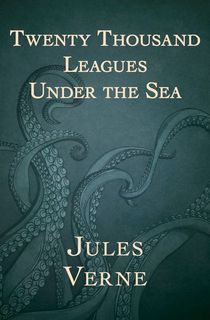As the second most translated author in the world (behind Agatha Christie), Jules Verne is considered the father of science fiction. Throughout his career, he wrote over 50 plays, novels, and essays that have earned him lasting fame. Journey to the Center of the Earth, Around the World in 80 Days, and Twenty Thousand Leagues Under the Sea are just a few of his most well-known stories. But unknown to most, Verne’s peers repeatedly rejected him, and his works were considered outlandish and ridiculous. What they didn’t realize was that he would someday become one of the most read writers in history.
You may be surprised to learn the following nine facts about the mysterious and brilliant Jules Verne. Have more facts you’d like to share? Post them in the comments!
1. He wrote a play.
In 1849, Verne met Alexandre Dumas, author of The Count of Monte Cristo and The Three Musketeers, and became close friends with Dumas’ son who shared his name. Verne and Dumas (the son) revised Verne’s stage comedy, Les Pailles rompues (The Broken Straws) together, and it debuted in Paris in 1850—serving as Verne’s literary debut.

Alexandre Dumas, fils (the son).
Photo Credit: Wikipedia2. He unknowingly predicted electric submarines.
In Twenty Thousand Leagues Under the Sea, which was published in 1870, Verne describes Captain Nemo’s ship as an electric submarine. This technology, however, that would not be invented for another 25 years—and Verne got it almost exactly right. When the first one was officially created in 1886, it was named the Nautilus after Verne’s creation.
RELATED: Who Is H.G. Wells? Exploring the Sci-Fi Legacy of The Time Machine Author
To accompany the electric submarine, Verne also predicted a handful of other technologies we have today such as newscasts, solar sails, lunar modules, skywriting, video conferencing and splashdown spaceships.
3. He wrote a novel depicting an eerily familiar world.
In 1863, Verne wrote a novel based in the 20th century that turned out to be freakishly accurate. It featured glass skyscrapers, high-speed trains, calculators, a worldwide communications network, and a society in which only business and technology are valued. In the novel, which is titled Paris in the Twentieth Century, despite all the wonders of his modern world the protagonist cannot find happiness. Verne’s publisher thought the book was too unbelievable and wouldn’t sell, so it never saw the light of day. It was only discovered in 1989 by Verne’s great grandson, Jean Jules Verne, and then published in 1994.
4. An attempt was made on his life.
In 1886, Verne’s beloved nephew Gaston tried to kill him with a pistol. The 26-year-old fired twice—the first bullet missed, but the second hit him in the shin, leaving Verne with a limp for the rest of his life. After the incident, Gaston was committed to an asylum and treated for mental illness for the rest of his life.
5. One of the first things he did upon publishing his work was buy a boat.
With this boat, Verne and his wife traveled through the British Isles, and to North America where they made their way up the Hudson River to Niagara Falls. These travels would serve as inspiration for The Extraordinary Voyages Collection, a series of 54 novels Verne published throughout his life.

A typical in-8º Hetzel cover for the Voyages Extraordinaires. The novel is Les Aventures du Capitaine Hatteras au Pôle Nord, and the cover style is "Aux deux éléphants" ("With two elephants").
Photo Credit: Wikipedia6. Two of his closest friends and advisors were Alexandre Dumas and Victor Hugo.
Though he worked on a play with Alexandre Dumas’ son, Verne was also close with the author of The Three Musketeers. Along with Victor Hugo, author of The Hunchback of Notre Dame, the pair were dear friends and trusted confidants of Verne’s. When most other writers at the time gave Verne heavy criticism, these two helped spur him forward to achieve great fame.

Portrait photograph of Victor Hugo published in the widely distributed serial publication entitled Galerie contemporaine, littéraire, artistique.
Photo Credit: Wikipedia7. He helped invent a genre of literature: travel writing.
Shortly after his first work was published, Verne met the grandiose explorer Jacques Arago, whom he admired greatly. The two became good friends, and Verne took the nearly-blind Arago’s travel journals and edited them so they could be more accessible to the public.
.jpg?w=32)
Jacques Arago
Photo Credit: Wikipedia8. He was a surprisingly good broker.
Though Verne was studying to be a lawyer, he abandoned that pursuit for a love of writing—much to the dismay of his father. After he was cut off financially, Verne worked as a stockbroker while pursuing his creative goals. He was shockingly talented at the work, though he deeply despised it.
9. During the 20th century alone, Verne’s works were translated into 140 languages.
It wasn’t until later in Verne’s life that he gained notable fame. And still today, his works are widely circulated. Some that had previously been unpublished made it into the hands of readers thanks to Verne’s son, Michel Verne.
Featured photos: Wikipedia
This post is sponsored by Open Road Media. Thank you for supporting our partners, who make it possible for The Portalist to celebrate the sci-fi and fantasy stories you love.
KEEP SCROLLING FOR MORE OUT-OF-THIS-WORLD STORIES




